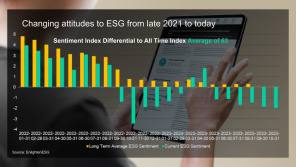ESG ETFs are proliferating as demand for socially responsible investments continues to rise.
Last year, European investors poured a record €120bn into sustainable investment options, according to data from Morningstar, the fund management research group.
Assets under management in European sustainable investment funds is up 58 per cent from 2018, and is racing towards the €700bn mark (at the end of 2019, European AUM in sustainable funds had reached €668bn, with more than a third of last year’s inflows, €47.3bn, coming in the final three months of
the year, according to Morningstar).

With so much choice on the market, investors looking to make allocations to ESG ETFs face a tough challenge
One of the easiest ways to access sustainable exposure is to buy an ESG (environmental, social and governance) exchange-traded fund. ETFs are funds that trade on exchange like stocks.
That means they are liquid, transparent and easy to trade. As ‘passive’ products, which means they track an index as opposed to being actively managed, and with competition in the ETF market being so intense, fees are generally low.
In an environment of low interest rates and meagre returns in many asset classes, ETFs are becoming increasingly popular with all types of investors.
The combination of soaring demand for ESG exposures and ETFs becoming a vehicle of choice for accessing markets has led to a proliferation of ESG ETFs.
At the end of last year, ETF analysis firm ETFGI reported that assets invested in ESG ETFs and ETPs (exchange-traded products) listed globally
reached a new record of $52.35bn at the end of November 2019, with 118 ESG products now listed in Europe.
With so much choice on the market, investors looking to make allocations to ESG ETFs face a tough challenge when it comes to distinguishing between products and product providers.
One obvious piece of analysis that can be done is to look in detail at the underlying characteristics of the ESG index being tracked.
For example, if the climate challenge is especially important to the investor then they might look for a product that explicitly filters out high carbon intensity companies.
Not all ESG indices exclude companies specifically on the basis of their carbon footprint – although many of the ESG indices that do not have an explicit carbon filter will implicitly filter out high carbon intensity stocks.
ETF or index providers can produce key performance metrics on specific ESG aspects of a particular index, such as its overall carbon intensity, which advisers may wish to present to investors.
Understanding the characteristics of the ESG ETF's underlying index is therefore important, but it is only one part of the socially responsible investment challenge.











